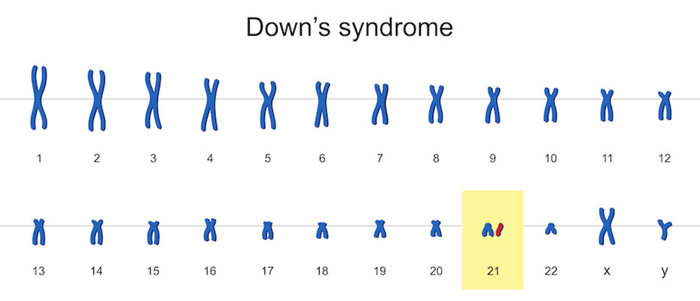
How does X-inactivation work?
September 12, 2005

- Related Topics:
- X linked inheritance,
- Trisomy/Aneuploidy,
- X inactivation
A curious adult from California asks:
“I have some questions about X inactivation. When does X inactivation take place? Is it possible to artificially induce X inactivation? Might that be useful for males with Klinefelter’s syndrome?”
What fun questions! X inactivation is really fascinating. It is why, for example, Calico cats look the way they do. Or why some women have patches of skin lacking sweat glands!
Before answering your questions, let's go into a bit of detail about X inactivation. If you don't need the intro, you can skip ahead 10 paragraphs or so to get directly to the answers.
Most men have one X chromosome, while most women have two. X inactivation is the process where one of a woman's X chromosomes gets shut off.
This process makes it so that both men and women have one working X chromosome. The reason this happens has to do with genes.
Remember, genes are just recipes for proteins. They tell the body what and how much of a protein to make.
And it is the how much that is important for X inactivation. If there was no X inactivation, people with two X chromosomes would make twice as much of all 1100 or so proteins encoded by genes on the X chromosome.
For some genes, this isn't a big deal. For example, some of us have blue eyes because a gene that makes brown pigment is broken. A broken gene is effectively the same as a deleted or missing gene.
So, people with brown or green eyes have more working copies of genes that make eyes darker, compared to people with blue eyes. No harm in that. But not every case of an extra or missing gene is so benign.
An example where extra copies of genes can be a problem is Down syndrome. Down syndrome happens when someone has an extra chromosome 21. The symptoms arise from the extra protein made from the additional copies of the ~225 genes on this chromosome.
Actually, not all of those genes are involved. There are some people with Down syndrome who only have an extra piece of chromosome 21. By looking at many of these patients, scientists have narrowed the region that causes Down syndrome to 33 genes. In other words, when your body makes more protein from these extra 33 genes, you end up having Down syndrome.
Chromosome 21 is one of the few chromosomes where you can live for long with three of them. Most of the others result in severe problems or, usually, death. So we wouldn't be able to tolerate the extra 1100 genes of the X chromosome.


Given how about half of our species has one X chromosome, while the other half has two X chromosomes, this can pose a bit of a problem. And it's not just a challenge for humans - this is true for all mammals. (Though it works a bit differently in other animals; click here to see how other animals determine sex). What biology came up with was X inactivation.
Very early on, probably when female embryos are only 32 cells big, an X chromosome shuts off randomly in each cell. In other words, it isn't always the same X chromosome that gets shut off in each of these 32 cells.
Each of these cells then gives rise to billions and billions of other cells. So females have swaths of cells that have one X turned on and other patches with a different X on. This is called mosaicism.
Calico and tortoiseshell cats
The classic mosaic example is a calico cat. One of the genes for hair color is found on the X chromosome. The gene makes either orange or black. White is on a different chromosome. Cats with orange, black, and white are called calico. Cats with just orange and black are called tortoiseshell.


Each colored patch on a tortoiseshell has a different X turned on. If the patch is orange, then there are a bunch of cells there with the orange X on. A black patch has a bunch of cells with the black patch on.
This is why a male tortoiseshell is so rare. Most males only have a single X and so either the orange or the black hair color gene, not both.
We talked earlier about how having extra chromosomes is usually lethal. One of the exceptions to this rule is the X chromosome.
This makes sense if extra X's get shut off anyway. And yet, there are health consequences for people who are missing an X or have extra copies of the X chromosome.
An example of this is what you were asking about, Klinefelter syndrome. A person with Klinefelter syndrome has a Y chromosome and more than one X chromosome.
If X inactivation were complete, this shouldn't be a problem -- these folks should be typical males. And yet, as the fact that they have a syndrome implies, they may have health problems. Why is this?
First off, only one of their X chromosomes is active. Having the Y chromosome doesn't seem to affect X inactivation itself.
The problem comes from the fact that X inactivation is not complete. X inactivation starts at the middle of the chromosome and spreads towards the ends. Apparently it peters out before it makes it all the way. The genes at the ends that are still on cause Klinefelter's syndrome.
But the incomplete X inactivation is OK for women -- these genes are supposed to be double expressed in females. The petering out process doesn't stop at the same place for each woman. So some women have different genes turned on at different levels. Scientists are exploring what having more or less of these extra genes might mean for women.
As you can tell, the extra X chromosome in Klinefelter's is already inactivated. To "cure" Klinefelter's, scientists would need to learn how to completely shut off the extra X chromosomes very early on without affecting the active X. A pretty tall order that is unlikely to happen sometime in the near future.

Author: Dr. D. Barry Starr
Barry served as The Tech Geneticist from 2002-2018. He founded Ask-a-Geneticist, answered thousands of questions submitted by people from all around the world, and oversaw and edited all articles published during his tenure. AAG is part of the Stanford at The Tech program, which brings Stanford scientists to The Tech to answer questions for this site, as well as to run science activities with visitors at The Tech Interactive in downtown San Jose.
 Skip Navigation
Skip Navigation
